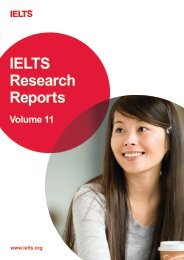INTRODUCTION - ielts
INTRODUCTION - ielts
INTRODUCTION - ielts
You also want an ePaper? Increase the reach of your titles
YUMPU automatically turns print PDFs into web optimized ePapers that Google loves.
IELTS Speaking Test introduced in 2001, the test developers were keen to investigate the<br />
effectiveness and validity of the planning time and how test-takers make use of it.<br />
Interestingly, Wigglesworth and Elder’s experimental study found no evidence that the<br />
availability of planning time advantages or disadvantages candidates’ performance, either in<br />
terms of the discourse they produce or the scores they receive. Despite this finding, the<br />
researchers recommend that one minute of pre-task planning should continue to be included on<br />
Part 2 in the interests of fairness and for face validity purposes. An important dimension of this<br />
study was that it canvassed the candidates’ own perceptions of the planning time available to<br />
them; feedback from test-takers suggests they perceive the one minute as adequate and useful.<br />
This study therefore offers positive support for the decision by the IELTS test developers to<br />
include a small amount of planning time in the revised Speaking Test; it also confirms that there<br />
would be no value in increasing it to two minutes since this would be unlikely to produce any<br />
measurable gain. Another useful outcome from this study is the feedback from both researchers<br />
and test-takers on possible task factors relating to topic; this type of information is valuable for<br />
informing the test writing process.<br />
Volume 6 includes two studies by Annie Brown who has a long association with the IELTS<br />
Speaking Test dating back to the early 1990s. Findings from Brown’s studies of the Test as it<br />
was then (some of which formed the basis of her doctoral research) were instrumental in<br />
shaping the revised Speaking Test introduced in 2001. The first of the two studies in this<br />
volume examined the validity of the analytic rating scales used by IELTS examiners to assess<br />
test-takers’ performance. When the Speaking Test was revised, a major change was the move<br />
from a single global assessment scale to a set of four analytic scales that all IELTS examiners<br />
worldwide are trained and standardised to administer. The IELTS partners were therefore keen<br />
to investigate how examiners are interpreting and applying the new criteria and scales, partly to<br />
confirm that they are functioning as intended, and also to highlight any issues that might need<br />
addressing in the future.<br />
Brown’s study used verbal report methodology to analyse examiners’ cognitive processes when<br />
applying the scales to performance samples, together with a questionnaire probing the rating<br />
process further. The study’s findings provided encouraging evidence that the revised assessment<br />
approach is a significant improvement over the pre-revision Speaking Test in which examiners<br />
were relatively unconstrained in their language and behaviour and used a single, holistic scale.<br />
Firstly, the revised test format has clearly reduced the extent to which an interviewer’s language<br />
and behaviour is implicated in a test-taker’s performance. Secondly, examiners in this study<br />
generally found the scales easy to interpret and apply, and they adhered closely to the<br />
descriptors when rating; they reported a high degree of ‘comfort’ in terms of both managing the<br />
interaction and awarding scores. The study was instructive in highlighting several aspects that<br />
may need further attention, including some potential overlap between certain analytic scales and<br />
some difficulty in differentiating across levels; however, Brown suggests that these can<br />
relatively easily be addressed through minor revisions to the descriptors and through examiner<br />
training.<br />
Brown’s second study in this volume is a partner to the first. It too sought empirical evidence to<br />
validate the new Speaking Test scale descriptors but through a discourse analytic study of testtaker<br />
performance rather than a focus on examiner attitudes and behaviour. Overall, the study<br />
findings confirmed that all the measures relating to each analytical criterion contribute in some<br />
way to the assessment on that scale and that no single measure appears to dominate the rating

















